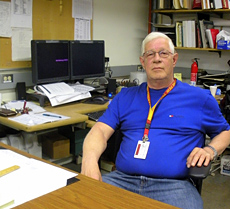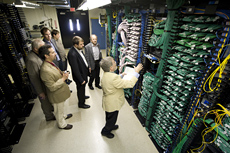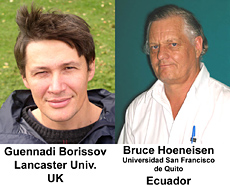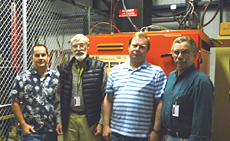|
Have a safe day!
Thursday, May 27
2:30 p.m.
Theoretical Physics Seminar - Curia II
Speaker: Anibal Medina, University of California, Davis
Title: Continuum Superpartners
3:30 p.m.
DIRECTOR'S COFFEE BREAK - 2nd Flr X-Over
Special Fermilab Colloquium - 1 West
Speaker: Yuri Oganessian, Joint Institute for Nuclear Research, Dubna, Russia
Title: Heaviest Nuclei: New Element with Atomic Number 117
Friday, May 28
3:30 p.m.
DIRECTOR'S COFFEE BREAK - 2nd Flr X-Over
THERE WILL BE NO JOINT EXPERIMENTAL-THEORETICAL PHYSICS SEMINAR THIS WEEK
Click here for NALCAL,
a weekly calendar with links to additional information.
Upcoming conferences |
|
For information about H1N1, visit Fermilab's flu information site.
|
|
Thursday, May 27
- Breakfast: Apple sticks
- Santa Fe black bean soup
- Steak tacos
- Chicken wellington
- Chimichangas
- Baked ham & swiss on a ciabatta roll
- Assorted sliced pizza
- Smart Cuisine: Crispy fried chicken salad
Wilson Hall Cafe Menu
|
|
Thursday, May 27
Dinner
Closed
Wednesday, June 2
Lunch
- Bourbon baby back ribs
- Coleslaw
- Baked beans
- Lemon meringue pie
Chez Leon Menu
Call x3524 to make your reservation.
|
|
|
Merrill Albertus, AD's go-to guy, retires May 31
 |
| Merrill Albertus |
For more than 30 years, Merrill Albertus’ job has remained the same: keep the accelerator running. He has worked with more than one accelerator in that time, but now those accelerators need to run under someone else’s watch.
Albertus, hired as a technician in the Accelerator Division mechanical support group in September 1979, will retire May 31.
“Merrill has always had the ability to make everything look easy,” said Dave Augustine, Albertus’ supervisor. “I remember Merrill on his first day. He had a great smile, a winning attitude and red hair. The red hair is gone, but the great smile and the winning attitude are still there.”
During his career at Fermilab, Albertus led the iron worker crew that installed Tevatron devices, coordinated the decommissioning of the Main Ring and supervised magnets and beam lines . Most recently, he has led the main injector mechanical group. He has handled every challenge, from failed magnets to surprise leaks, with patience and calm.
Albertus has valued most the opportunity to mentor his group, whom he sees as his second family. He maintains an open-door policy in his office and co-workers recognize him as the ultimate go-to guy, eminently approachable and supportive.
“Merrill is by far the most down-to-earth, understanding, unselfish person I have worked with and worked for here at the laboratory,” said Scott McCormick, who works under Albertus’ supervision. “He’s not the type to supervise from upstairs. Instead, he’d go down in the tunnel and work alongside you.”
During his retirement, Albertus plans to motorcycle across country, visit his children and, as he says, “terrorize” his grandkids.
He also intends to visit the Accelerator Division from time to time and carry on his long-standing tradition of weekly lunches at Chez Leon.
“I’ve been doing that for nearly 29 years and I won’t give that up,” he said.
-- Daisy Yuhas
|
Czech visit
 |
| Representatives from institutions in the Czech Republic that collaborate with Fermilab toured last week the Grid Computing Cener as well as DZero and the New Muon Lab. |
|
Matter, Antimatter, And Existence
From the NPR, May 25, 2010
Last week, the headlines were buzzing with news from Fermilab, the huge particle accelerator some 40 miles west of Chicago: "A New Clue To Explain Existence," read the article by Dennis Overbye, from The New York Times.
Very catchy title. (Too bad he didn't mention my new book, which is all about the importance of this and other asymmetries. The timing couldn't have been any better.) However, some of the readers complained of the need to mix up science and religion even when reporting on a particle physics experiment. Case in point, Overbye quotes a (very good) theoretical physicist from Fermilab, Joe Lykken: "So I would not say that this announcement is the equivalent of seeing the face of God, but it might turn out to be the toe of God." Lykken was referring to the comment Nobel Prize winner George Smoot made when reporting on his team's findings of the temperature properties of the microwave background radiation, the leftover "light" from the period when the first atoms were made, just some 400,000 years after the Big Bang: "it was like looking at the face of God." Does the existence of matter and antimatter really have anything to do with God? If so, what? And if not, why is there a need to invoke God when publicizing results in cosmology?
Read more
|
Physicists hold first international particle accelerator conference
From symmetrybreaking, May 24, 2010
For decades, scientists from laboratories and universities around the world have worked together to build and operate particle detectors.
Until recently, accelerator physicists have done just the opposite, working predominantly with fellow scientists at the same institution to build their machines.
This week hundreds of accelerator physicists have gathered in Kyoto, Japan, to take part in the first International Particle Accelerator Conference, taking a step toward the practices of their detector-building colleagues. "Any new accelerator will surely need to be built in an international collaboration," said Katsunobu Oide, chair of the IPAC 2010 organizing committee, in his introductory remarks.
Detector builders expect to work with collaborators from outside their institutions. If a particle physicist wants to take part in an experiment, he or she must take some responsibility for the detector by helping with construction or taking shifts running it.
Read more
|
|
|
Why are we made of matter?
 |
| In this analysis, we have observed a preference for antimatter to convert into matter. It is possible that this result will reveal why we live in a matter-dominated universe. |
Last week, DZero’s press release on a new physics result got lots of media attention. I imagine that Fermilab Today readers are wondering what the buzz is all about.
The result looks at one of the biggest mysteries in the evolution of the universe. Here at the Tevatron, we can convert pure energy into equal amounts of matter and antimatter. We expect that this also occurred in the early instants of the universe,
However, the rules of physics run both ways. Matter and antimatter can also convert back to energy. In a universe with equal amounts of matter and antimatter, we’d expect most of it to annihilate, leaving nothing.
And yet our universe seems to be composed wholly of matter. The perfect balance between matter and antimatter couldn’t have applied in the early universe. This is the basis of one of particle physics’ biggest conundrums.
In the 1960s, physicist discovered a few effects that seemed to favor matter over antimatter. However the effects were not big enough to solve the mystery. Consequently, scientists continued to look at the data to help understand what is going on. In the subsequent years, we have learned a lot, but the answer has thus far eluded us.
We know that particles called neutral B mesons can fluctuate from matter to antimatter and back again, like a seesaw going up and down. In this analysis, we looked at the decays of these B mesons, specifically decays involving muons. If we saw an event with two muons of negative electrical charge, antimatter had converted into matter. Events with two positively charged muons indicated matter had converted into antimatter. If the laws governing this reaction were symmetric, we’d expect to see equal numbers of positive and negative muon events.
The result of this experiment is that there were more events with two negative muons, indicating a preference for matter. This result was not expected and may prove to be a crucial piece of the puzzle.
DZero scientists caution readers that there remains a tenth of a percent chance that this result is just a random fluctuation. Still, those are betting odds, and that’s why we are so excited. Ongoing research will further clarify the situation, and we look forward for independent confirmation. There’s an excellent chance that this evidence is an important discovery.
-- Don Lincoln
 |
| These physicists were behind this very tricky analysis. |
 |
| A crucial component of this analysis required that the polarity of DZero magnets be periodically changed. This crew is responsible for DZero's stable magnet operations. From left to right: Russ Rucinski, Eugene Fisk, Michael Sarychev, Walter Jaskierny. |
|
|